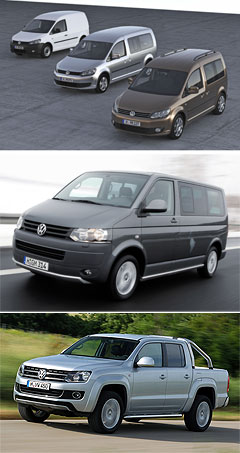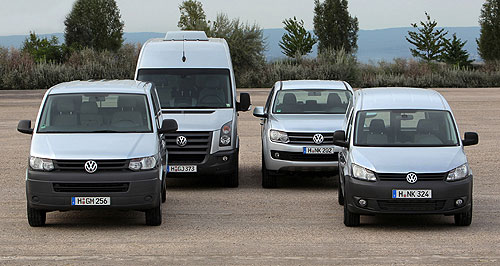Make / Model Search
Future models - Volkswagen - Mini VanVW eyes sub-Caddy vanVan fan: Volkswagen is mulling a van smaller than the Golf-based Caddy. The emerging 500kg van market in Europe has Volkswagen thinking hard8 Sep 2010 VOLKSWAGEN is considering introducing an additional model to its four-strong commercial vehicle line-up. To slot beneath the Caddy, it would be a city-sized delivery van to compete against the likes of the Fiat Fiorino, Peugeot Bipper and Citroen Nemo. An existing or future Polo architecture would most likely be the basis for the littlest Volkswagen van, although the firm’s recent part-acquisition of Suzuki of Japan might be another avenue to explore. The Type 2K Caddy is based on the current-generation Golf small-car platform, and is most closely related to the Touran small people-mover that we do not see in Australia. It operates in the three-quarter to one tonne (750-1000kg) payload class, so there is plenty of downward scope for a range of Volkswagen commercial vehicles with payloads in the 400-650kg carrying capacity class. Interestingly, the previous-generation, 9K Caddy from 1995 to 2003 was spun off the A03 Polo platform, and was built in Spain by SEAT. It also spawned the SEAT Inca van. And before that, the original, Type 14 Caddy was essentially a Mk1 Golf utility introduced in 1979. But don’t hold your breath for another baby Volkswagen van, because no decision has been made, meaning that the likelihood of such a vehicle coming on stream before the middle of this decade is slim.  From top: VW Caddy range, VW T5 Multivan and VW Amarok. From top: VW Caddy range, VW T5 Multivan and VW Amarok.“Yes, we are thinking about it,” revealed Robert van der Wal, Volkswagen AG board member and quality manager for commercial vehicles, told GoAuto at the international launch of the Caddy GP in Frankfurt this month. “But we have to admit … we haven’t really taken it any further yet. It has to fit into our portfolio. “We do have to stay (that we will stay) in contact with the Polo people (engineers) in the future (but) the Caddy right now is enough.” Mr van der Wal revealed that Volkswagen was carefully monitoring the baby van market as it decided its next step, but the timing was not quite right. “We are looking very closely at the market, but the figures and data we have right now (suggests that it is not a priority) and that we have to focus on the Caddy, T5 and especially the Amarok.” Volkswagen Australia commercial vehicle boss Phil Clark agreed that the company would not ignore an emerging mainstream market, and that a decision to go down to the next level below Caddy is a strong possibility. Asked if such a vehicle would be imported to Australia, Mr Clark said that it would depend on a wide range of circumstances, but admitted that he would love to offer a baby van in this country. “I would certainly put my hand up for it. But it is not on the horizon for now,” he said. “For Australia, it would all depend on the payload capacity. It would have to be well under what the Caddy offers – below 500kg – before we would put our hand up. Otherwise it would be too close to Caddy territory. The Caddy is our representative in the 500kg to 800kg payload market. “It would make sense to use something like a Polo platform because the Caddy uses the Golf platform, and – as the Maxi shows – it is easier to stretch that up rather than down.” According to Mr Clark, it is clear that Volkswagen would have to eventually find a partner if it is to expand into new segments within the commercial vehicle realm. “Most manufacturers find it is much easier to go into partnerships,” he said. Unveiled in 2007, the Fiorino/Bipper/Nemo that serves as a baby van template for Volkswagen to follow is a co-op between the Italian and French brands, and is based on the Punto platform. But it is actually a co-development with Turkish carmaker Tofas, which also builds each version as well as a variation of its own for the home-market. One model-sharing scenario for Volkswagen is that it leverages Suzuki know-how, which is 19.9 per cent owned by the German conglomerate. The Japanese firm has decades of experience building small vans, with its famous Carry line of light commercial vehicles stretching back to 1961. Suzuki also has a very covetable relationship with, as well as a 54.2 per cent stake in, Maruti of India, potentially providing a low-cost production base for Volkswagen in the future. With rising fuel prices, production costs and labour rates, and lower emissions requirements all putting the squeeze on commercial vehicles in Europe, a Volkswagen insider acknowledged that a Polo-based van is inevitable. He also suggested that the next-generation Caddy expected from about 2015 would grow and evolve to make room for a baby brother. Currently Volkswagen’s commercial vehicle range consists of the Caddy, T5 Transporter and Multivan, Crafter and Amarok one-tonne utility. The Crafter – which is also due for a makeover in about a year’s time – is the three to five tonne van lovechild of Volkswagen’s long association with Mercedes-Benz, and is built alongside (but different in many key ways to) the Sprinter that it competes head-on with.  Read moreAll future modelsMotor industry news |
Click to shareVolkswagen modelsResearch Volkswagen All future modelsMotor industry news |



 Alfa Romeo
Alfa Romeo Abarth
Abarth Audi
Audi Aston Martin
Aston Martin BMW
BMW Bentley
Bentley Ferrari
Ferrari Chevrolet
Chevrolet Ford
Ford Fiat
Fiat GWM
GWM Foton
Foton Hyundai
Hyundai Honda
Honda Jaguar
Jaguar Isuzu
Isuzu Kia
Kia Jeep
Jeep Land Rover
Land Rover Lamborghini
Lamborghini Maserati
Maserati Lexus
Lexus McLaren
McLaren Mazda
Mazda Mercedes-Benz
Mercedes-Benz Mitsubishi
Mitsubishi Mini
Mini Peugeot
Peugeot Nissan
Nissan Ram
Ram Porsche
Porsche Rolls-Royce
Rolls-Royce Smart
Smart Skoda
Skoda Suzuki
Suzuki Subaru
Subaru Toyota
Toyota Tesla
Tesla Volvo
Volvo Zeekr
Zeekr







Facebook Twitter Instagram